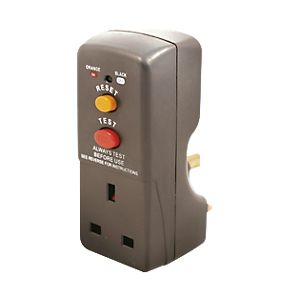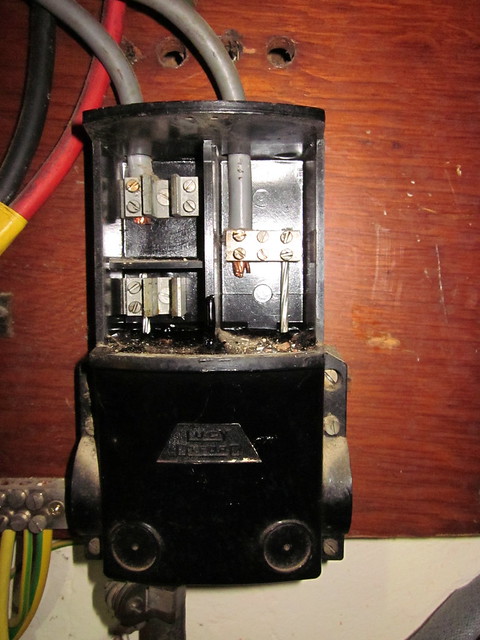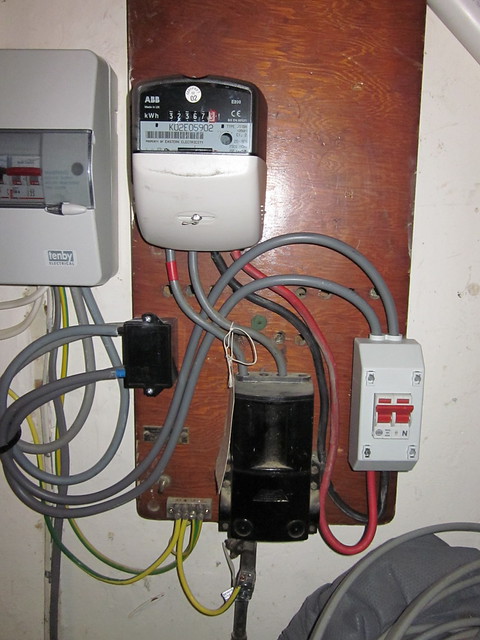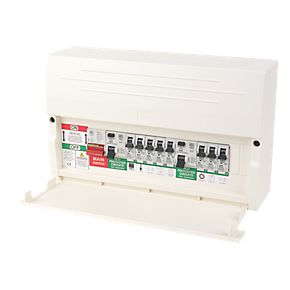- This topic has 59 replies, 23 voices, and was last updated 9 years ago by gofasterstripes.
-
Big saw on a long extension lead keeps tripping. How do I uprate the supply?
-
MidlandTrailquestsGrahamFree MemberPosted 9 years ago
This is the saw.
I had to get a friend to lift it in to place with a JCB, so moving it closer to the house and using a shorter lead isn’t really an option.
It’s fed via about 20m of heavy extension cable plugged in to one of these.
The data plate on the motor says 11/5.5 amps.
I’m guessing that’s maximum load and off load consumption, although it seems to have a two stage switch of some sort, as it starts off slow, then suddenly kicks in to a higher speed after a few seconds, so maybe it’s a higher starting current.
If the motor is only 11A, then I’m also guessing it’s the added resistance of the 20m extension cable that is causing it to tripIt runs fine for a long time cutting tiling laths, but after a while, anything bigger trips it out.
It’s a normal 13A household plug on the saw. I really ought to upgrade it with a weatherproof NVR switch and emergency stop button.The obvious answer to me is to run two 13A extension leads and RCD adapters in parallel wired in to one NVR switch in the saw.
No doubt, this won’t comply with any official code of practice, but is it actually dangerous?
Is there a safer way to do it?footflapsFull MemberPosted 9 years agoIf you have an appliance which needs more than 13A you normally run it off a dedicated MCB from the consumer unit and use an uprated plug / socket / cable e.g. this will of 32A single phase:
Quite common for running a welder etc that might want 20A.
However if it is rated for 11A and tripping 13A, I’d suggest it’s faulty…..
Although looking at the size of that motor, it looks like way more than 11A!!!!
rwamartinFree MemberPosted 9 years agoWhat trips? The fuse in the plug, the RCD or the MCB in the board?
If it’s the mcb you have probably got a B curve fitted. A “C” curve mcb will handle the higher startup current of the motor.
Obviously difficult to tell without seeing the setup in the flesh.
Rich.andylFree MemberPosted 9 years agoMight be worth checking out the electrics for a bad connection that could be getting hot and leading to higher current.
I think I would definitely be getting a higher power single phase supply wired in though if it’s a long term thing.
5thElefantFree MemberPosted 9 years agoI’d try a heavier gauge cable, unless your heavy cable is really very heavy…
andylFree MemberPosted 9 years agoDon’t those things just protect against an imbalance of current and not trip on level of current?
Maybe the RCD itself is getting hot if running at near maximum current and it has a safety trip for heat?
MidlandTrailquestsGrahamFree MemberPosted 9 years agoI’ve only got two ancient Bakelite fuses feeding the whole bungalow, a 5A and a 20A.
The mice chewed through the old wiring, so all I’ve got at the moment is a double socket fed off the 20A fuse, with two of those RCDs pictured above plugged in to that and extension leads from there on.
I know it sounds a bodge, but I’m doing some major renovation on the bungalow and will do the electrics properly one day, but for now, while I’m not living here full time, I’m just running a couple of lights, a PC and a fridge. And this saw of course.What if I was to buy;
This MCB
This enclosure. Is it compatible?
This extension lead
This plug for the saw
This socket
This NVR switch, or probably search for a waterproof one.
Then wire it all in to my existing 20A fuse, until I get around to fitting a proper consumer unit?MidlandTrailquestsGrahamFree MemberPosted 9 years agoWhat trips? The fuse in the plug, the RCD or the MCB in the board?
The RCD. The 20A fuse on the board and the 13A fuse in the extension lead and saw are OK.
Don’t those things just protect against an imbalance of current and not trip on level of current?
Dunno, this is where I’m out of my depth.
I just assumed it was like a resettable fuse and if it’s rated at 13A, then it will trip at a higher load.trail_ratFree MemberPosted 9 years agoThe physical size of the motor – isnt that a red herring in this case – its likely to be an induction motor given physical size use and age. Does it have an hp rating ? I would expect between 2 and 3 but given the age it could less given the age perhaps.
If its induction it will be 11amp on the start up circuit and 5 amp once running ?
The under load tripping confuses me though – sounds like something not right on your wiring and your shorting under load according to the rcd.
Does it work fine if you take the plug rcd out of the equation , its not been unheard of that once you start tripping those , especially cheaper ones they become easier and easier to trip.
trail_ratFree MemberPosted 9 years ago3hp single phase under full load wants to draw 14amps +- 10%
3hp is generally biggest you would typically see on a single phase system.
I have a couple of 1.5hp induction motors – you can see the lights dim when they start up.
My mates 3hp belt drive compressor even wired in right by an electrician through a 32 amp plug on a short hd flex and a propper feed from the metre still dims his lights,briefly when it starts up.
showermanFree MemberPosted 9 years agoi do not wish to sound rude but i hope you have a lot of fire protection at your disposal. biggest cause of fire is over loading supplies everything from bakerlite fuses reduced to a double socket is a ticking timebomb. see it most days people do not see the problems until the fire brigade are bashing down the door
safty first big boys toys second.rwamartinFree MemberPosted 9 years agoThe purpose of the MCB/Fuse is to protect the cable so it doesn’t overload, get hot and catch fire. The RCD is to protect against electric shock by ensuring that the power is disconnected within 300 milliseconds and the current doesn’t rise above 30millamps (a bit simplistic, but accurate enough).
You need to ensure that the cable you are feeding the saw with has a current carrying capacity greater than the demand being put on it and the fuse/mcb rating is greater than, or equal to both the demand and current carrying capacity of the cable.
Lets assume the socket the RCD is plugged into is on a ring and it’s run in 2.5FTE. This will
have a cable rating of 27ampsbe satisfactory due to the way a ring works and a fuse/MCB of 32A so likely all ok.The plug on the extension cable is going to be rated at 13A and 1.5mm Flex is rated at 16Amps so all ok here. We’ll also assume that the cable is fully extended.
MCB isn’t tripping, so no cable overload in the house. Fuse not blowing on the plug, so no overload there.
RCD trips implies an earth fault. Not sure if there is an RCD in the house protecting the circuit(?). The most sensitive RCD will trip first.
If the circuit has a 30mA RCD protecting it on the main board, take the plug in RCD off and try the saw. If the house RCD goes, it will eliminate the plug in RCD and confirm an earth fault. If there is no house RCD don’t do this, but try a different plug in RCD to see if the tripping persists. If not, then it’s a faulty RCD otherwise you still have an earth fault on the saw.
The RCD at the plug tripping indicates the fault is between the RCD and saw as the RCD would not trip with a fault “north” of this.If an earth fault is suspected, power off and check for a loose neutral connection in the plug and also at the saw. Heavy load could be causing an increase in temperature in the RCD. Not sure whether there is a thermal cutout in the RCD or whether an increase in temperature could make it excessively sensitive.
Failing that, I would have the saw and extension cable tested to ensure that the LN-E Insulation resistance is satisfactory.
Rich.
edit:
Don’t dual up the conductors – It’s not safe and I don’t think it would solve it anyway.MidlandTrailquestsGrahamFree MemberPosted 9 years agoshowerman, I think you’re being a bit dramatic there.
Running an 11A motor through a 20A fuse isn’t overloading anything. I put the 13A RCD in for additional protection and that’s what’s tripping out exactly as it should.
Or perhaps not exactly, if Trail rat is right about them becoming over sensitive with age and use.It’s a 2hp motor.
The extension lead is fully unrolled.It’s fine cutting 25×38 laths, it’s when I try cutting anything bigger that it trips.
My guess is that the voltage drop of the long lead is increasing the current draw when the saw starts to slow down on thicker timber.EdukatorFree MemberPosted 9 years ago16A RCD then.
Edit: but no higher unless you are sure everything is wired with 2.5mm2 cable.
MidlandTrailquestsGrahamFree MemberPosted 9 years agoThis is what I’m connecting to, it’s probably been there since the 1930s.
The loose tails at top right are disconnected.
Since taking the photo a couple of minutes ago, I’ve realised the switch box at top left doesn’t feed anything, so I’ve switched that off.
All that’s live is the double socket connected to one of the two Bakelite fuses. Everything in the bungalow, a fridge (100w), a couple of fluorescent lights (60w), an electric blanket (100w), a PC & monitor( 300w) plus a phone and drill charger run off the left hand RCD extension lead. Well under 1Kw peak load.
The right hand RCD and extension is just the saw or any other outdoor power tools.I know it looks a mess, but there’s no exposed wires, the insulation is all good and nothing is overloaded.
MidlandTrailquestsGrahamFree MemberPosted 9 years agoThanks for the comprehensive reply rwamartin.
As you can see, there’s no breakers in the house.
I don’t think it’s an earth fault, as it only trips when I’m cutting thicker logs.
Swapping the RCDs would help identify the fault, as the left hand one has never had a heavy load on it.Anyway, I’m off to Screwfix now for a new consumer unit and some other stuff to try and tidy that mess up.
andylFree MemberPosted 9 years agoAnyway, I’m off to Screwfix now for a new consumer unit and some other stuff to try and tidy that mess up.
Sounds like a good plan. It’s amazing how cheap the CUs are fully loaded with MCBs. You will spend half that on a couple of new plug in RCDs.
I’d fit a few dedicated high current outlets (like the blue one above)
Get some new wallpaper while you are out 😉 😀
rwamartinFree MemberPosted 9 years agoGet some new wallpaper while you are out
….and some 16mm singles, 10mm for bonding. Seals for the main fuse will be available on ebay…..
projectFree MemberPosted 9 years agoWhy is there a plug socket on side of saw table,
the riving knife is to far back, or the blade is to small in diameter,
the crown guard is not covering the top of the blade,
there is no guard on the drive pulley or what looks like a chain drive.
maccruiskeenFull MemberPosted 9 years agoI hope that saw was free ;-).
The robustness of the power supply might be one issue the other might be the blade being so undersized. The guard and reaving knife suggest the blade is less than half the size it should be, and that would mean the teeth will be hitting the wood at a around a third of the speed they should be. As you are progressing the wood you are cutting through the blade the teeth are making as third as many passes as they should be and are having to cut more material with less momentum and leverage to do that – which is why your giant saw is struggling to cut anything bigger than kindling.
You shouldn’t really deviate from the intended blade size by any amount at all, less than 60% if the designed size is deemed to dangerous rather than just rubbish.
tillydogFree MemberPosted 9 years agoOP: You may have a neutral to earth short in your extension lead or the saw. It will trip the RCD when the voltage drop down the neutral wire is enough to send 30mA down the earth wire, but not otherwise.
RCDs are not omnipotent – it will only trip when there’s electricity going up the “live” and not coming back down the neutral. Load, extension lead length, voltage surges and phase of the moon are irrelevant.
Believe your RCD – it is telling you there is a fault. All you need to do is find it. (Megger meter would be handy).
…what looks like a chain drive…
is an adjustable V belt.
Edit to add:
Since the RCD apparently doesn’t trip when a high current is drawn on start-up, the fault could be with the ‘run’ windings in the motor itself (I’m guessing it has a start & a run winding with a centrifugal change-over switch, as I can’t see a starting capacitor in the photo – may well be wrong, though).
PePPeRFull MemberPosted 9 years agoWe’ve been using those RCD’s for work and have had issues with them a lot!!!
MidlandTrailquestsGrahamFree MemberPosted 9 years agoThat’s the saw as bought.
It came with a selection of blades. I wanted to fit one of the bigger blades to cut thicker logs, but assumed that would make it even more likely to trip. It’s interesting to know that, counter intuitively, a big blade would cut easier.
You can see the adjustment for the guard. The height of the blade, or depth of cut is adjustable as well.There’s no guard on the underside of the table either, the lower part of the blade is exposed.
There’s a short lead from the motor with a 13a plug on the end.
That plugs in to the switched socket you can see.
That’s got it’s own longer trailing lead which I plug in to my extension lead.
It’s all a bit pre HSE in design.Before I put the RCD in line, it used to blow 13A fuses, so I still suspect it is an overload problem, not an earth problem.
If I switch the saw off, then switch it back on before it comes to a stop, it will blow the fuse/trip the RCD straight away.
I take it there’s a centrifugal switch for the two stage motor which doesn’t reset until it comes to a halt, so switching it back on while still spinning slowly is trying to build up speed on the lower setting, which it doesn’t like.
There’s no external capacitor, the cable goes straight in to the motor.footflapsFull MemberPosted 9 years agoThe first thing I did was put in an Isolator straight after the meter, so I didn’t have to keep opening up the Bakelite fuse…
[url=https://flic.kr/p/q2YDVN]100A Supply Fuse[/url] by brf, on Flickr
[url=https://flic.kr/p/q38hjT]IMG_1391-001[/url] by brf, on Flickr
I’ve since tidied up the tails and added a second consumer unit for the workshop…
maccruiskeenFull MemberPosted 9 years agoBefore I put the RCD in line, it used to blow 13A fuses, so I still suspect it is an overload problem, not an earth problem.
If I switch the saw off, then switch it back on before it comes to a stop, it will blow the fuse/trip the RCD straight away.If you’re fitting new breakers make sure they are ‘motor rated’, you don’t want something thats a higher rating than your lead out to the saw in terms of overall rating, but a motor rated breaker will tolerate an extra short-term load as the motor starts up
MidlandTrailquestsGrahamFree MemberPosted 9 years agoI bought this from Screwfix and wired it all in.
The consumer unit is fed from a 30a bakelite fuse in that metal fuse box, top left, in my picture above.
I’ve then wired the extension lead to a 16a MCB.
As soon as I switch the saw on now, it trips the 63a RCD.Is this likely to be a fault with the motor, or is there a less sensitive RCD or some sort of soft start switch I could buy that would cure it?
welshfarmerFull MemberPosted 9 years agoMake sure you have not inadvertently connected the negative tail for the 16amp spur to the wrong side of the consumer box (ask me how I know!). If you look at the negative bus bar you will see it is split in 2 parts. One part has RCD protection, the other not. If your positive to the 16 amp spur is from the RCD side of the box and the negative from the other side it will instantly trip the RD as soon as the saw is turned on.
maccruiskeenFull MemberPosted 9 years agoIs this likely to be a fault with the motor, or is there a less sensitive RCD or some sort of soft start switch I could buy that would cure it?
Motor-rated RCDs allow for an initial spike in load as a motor spins up. But if your tripping 63amps theres something fundamentally wrong somewhere. Like I said up there – I hope the saw was free.
MidlandTrailquestsGrahamFree MemberPosted 9 years agoI’m sure I’ve got it wired up correctly.
I’ve got the saw and extension lead on blue 16A plugs and sockets now.
If I buy a 16A plug to 13A socket adapter today, I can check that my wiring is OK by plugging 3kW worth of power tools in at the same time.MidlandTrailquestsGrahamFree MemberPosted 9 years agoThe RCD is rated at 63A 30mA.
Doesn’t that mean it can handle a total of 63A load, but will trip with a 30mA leakage to earth?
I’m trying to learn about all this as I go along, but it sounds more likely to me that I have got a 30mA earth leakage than a 63A short term load on start up.
It just seems odd that the new 30mA RCD built in to the consumer unit trips straight away, yet the old 30mA plug in adapter would at least let me cut thin sticks.I think I’d be best off taking the motor in to a local rewinder and getting them to check it.
welshfarmerFull MemberPosted 9 years agoIf it is wired wrongly as I detailed above (ie. negative not on the correct side of the Consumer unit bus bar for RCD protection) then you can test it with anything (you wont need 3KW!) as the instant a current flows in the circuit it will trip.
Best double check as the unit in your photo only seems to have 3 RCD protected outlets and it would be easy to stick the -tive wire in the wrong place.
EDIT. Sorry, just checked your link it is seems to have 2 RCDs in the CS. But still make sure your +tive and -tive for the 16 amp circuit are both on the same side of the unit.
MidlandTrailquestsGrahamFree MemberPosted 9 years agoWell, that’s embarrassing, and thank you WelshFarmer.
Spot the difference.
Before.
After.
I’d got the socket earth connected to the main earth busbar on the left. 😳
It seems to be working OK now with it connected to the RCD busbar, second from left. 😀welshfarmerFull MemberPosted 9 years agoSee. Not to worry, you are not the first and won’t be the last. When I phoned my electrician mate for his opinion on why mine did the same as you described he didn’t hesitate to tell me what he guessed I had done wrong. Seems to be one of the most common wiring errors out there.
EdukatorFree MemberPosted 9 years agoGood to hear you’ve got it working. In my mind the thing that’s missing in those picks is the big fat yellow and green earth cable coming from the metal stake hammered into the ground somewhere.
SlogoFree MemberPosted 9 years agoSorry OP but what the hell! you obviously don’t have a clue what you’re doing!
Call an electrician out immediately before something bad happens.
Ive seen worse consumer units. But I’ve seen better ones burn houses/boats down!
oldschoolFull MemberPosted 9 years agoMTG
The consumer unit is fed from a 30a bakelite fuse in that metal fuse box,
So you supplied a 63A RCD from a 30A Bakelite fuse? What you’ve done ‘works’ but it isn’t right.
MidlandTrailquestsGrahamFree MemberPosted 9 years agoIve seen worse consumer units. But I’ve seen better ones burn houses/boats down!
My goodness ! You do make DIY sound so exciting.
Going back to some of the less dramatic replies…
Earth sleeving; I’ll pick some up in Toolstation next time I’m there. It comes in 100m rolls, so I’m trying to think of something creative to do with the 99.5m offcut. Xmas decorations maybe.
“big fat yellow and green earth cable coming from the metal stake hammered into the ground somewhere”. Now you mention it, that is something missing from my system.
This is what I started with.Power in via two overhead cables coming through the wall, centre right.
Live goes through that grey box, presumably there’s a fuse or isolator inside to isolate the meter if required.
Neutral goes through the smaller black box, which has also got the thin earth wires from the two fuse boxes going in to it.Now, as far as I can tell, the incoming wires are not armoured, so I take it the earth wires are connected directly to neutral.
From what I’ve read here, I think I’ve got a TN-C-S system, although going by the diagrams here, I should have a separate earth spike.As for the saw, first step is to order a NVR switch, then fit the bigger blade and make some guards for the belt drive and the underside of the blade.
The topic ‘Big saw on a long extension lead keeps tripping. How do I uprate the supply?’ is closed to new replies.








